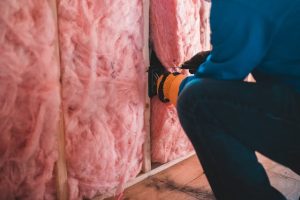
With winter approaching, now is the perfect time to assess and upgrade home insulation.
Colder weather often leads to increased heating usage, driving up energy bills and putting more strain on home heating systems.
Home insulation is one of the simplest, most effective upgrades to achieve eco-friendly living, especially cavity wall insulation, which holds immense potential for environmental and financial benefits.
This post explores why home insulation, particularly cavity wall insulation, is a smart, sustainable choice for homeowners, how it helps reduce energy bills, and how the latest UK initiatives are supporting greener housing.
How to utilise Eco-Friendly Insulations for a Greener Home with Green UK Initiatives

Seasonal discounts and government incentives are often available in the autumn and early winter months, encouraging more homeowners to insulate before the height of winter.
When it comes to insulation installation, finding a reputable installer committed to sustainable practices is crucial. One such installer is Insul8, a company renowned for its eco-friendly insulation services, providing quality cavity wall insulation designed to maximize energy efficiency. The company uses environmentally responsible materials and techniques that align with the latest industry standards for sustainability.
The UK government’s commitment to achieving net-zero carbon emissions by 2050 has placed a strong emphasis on energy efficiency in homes with the following initiatives:
- Green Homes Grant: This initiative provides vouchers for homeowners to cover part of the cost of installing energy-efficient improvements, including insulation.
- ECO Scheme: This program requires larger energy companies to fund energy-efficient home improvements, such as cavity wall insulation, specifically benefiting low-income households.
- Building Regulations for New Builds: The Future Homes Standard set for 2025 mandates new homes to achieve at least a 75% reduction in carbon emissions. This means insulation will be a fundamental part of future construction, setting a standard for energy efficiency.
What makes Cavity Wall Insulation a Must for Home Insulation?
Cavity wall insulation is a method of filling the gaps or “cavities” between the external walls of homes, typically constructed with two layers of bricks and a gap between them.
This gap can lead to substantial heat loss if left uninsulated, resulting in higher energy bills and increased carbon emissions. By filling this space with insulating material, such as foam, mineral wool, or polystyrene beads, homeowners can significantly reduce heat loss and create a warmer, more energy-efficient environment.
4 Green Benefits of Cavity Wall Insulation

Reducing energy waste is one of the core benefits of cavity wall insulation.
Here’s how it can make a difference:
1. Lower Carbon Emissions:
Insulating your home reduces the need for excessive heating, thereby cutting down the carbon footprint associated with heating systems, particularly in the colder months.
2. Resource Conservation:
By minimizing heat loss, cavity wall insulation helps conserve energy resources. This reduction in energy demand plays a part in conserving natural resources used in electricity generation.
3. Waste Reduction:
Installing high-quality insulation minimizes the need for heating systems to constantly run, leading to less wear and tear on appliances and ultimately less waste from replacement and repairs.
4. Sustainable Living:
Every small change contributes to a larger movement. Adding cavity wall insulation is an action toward eco-friendly living, supporting the global movement for a sustainable future.
4 Economic Benefits of Home Insulation
In addition to its environmental benefits, cavity wall insulation can make a noticeable impact on household finances. Here’s how:
1. Reduced Energy Bills:
With proper insulation, homes retain heat more effectively, meaning less reliance on heating systems. As a result, homeowners can see a drop in their monthly energy bills, offering a return on investment within a few years.
2. Increased Property Value:
A well-insulated home is more attractive to potential buyers, especially as the demand for eco-friendly housing grows. Improved energy efficiency ratings are a major bonus for those looking to sell or rent out their properties.
3. Government Incentives:
The UK government has recognized the importance of insulation as part of its green initiatives, including the Green Homes Grant scheme and ECO (Energy Company Obligation), which supports lower-income households with insulation costs.
4. Future Savings:
With energy prices on the rise, taking steps toward insulation now is a way to safeguard against potential increases in heating costs in the years ahead.
Final Thoughts
As winter draws near, now is an opportune moment to assess your home’s insulation needs and make upgrades that will benefit both the environment and your wallet. Investing in home insulation, especially cavity wall insulation, is a step toward a more sustainable, eco-friendly home.
Not only does it offer immediate financial benefits through lower energy bills, but it also supports the broader goal of reducing our environmental footprint. By choosing reputable, eco-conscious installers, homeowners can ensure their insulation project is in line with the latest sustainability standards, contributing to a greener future.
![]()
Author Profile

- Eco Warrior by day, Eco Blogger by night trying to get the eco balance right.
Latest entries
 Green Home GuidesApril 17, 2025How Heat Pumps Help Cut Household Carbon Emissions
Green Home GuidesApril 17, 2025How Heat Pumps Help Cut Household Carbon Emissions EnvironmentApril 17, 20256 Benefits of Wall Cladding for Eco-Friendly Renovations
EnvironmentApril 17, 20256 Benefits of Wall Cladding for Eco-Friendly Renovations EnvironmentMarch 31, 20255 Sustainable Materials for Building Your Dream Eco-Friendly Pergola
EnvironmentMarch 31, 20255 Sustainable Materials for Building Your Dream Eco-Friendly Pergola Best practicesMarch 25, 202510 Green Tips to Live a More Sustainable Lifestyle
Best practicesMarch 25, 202510 Green Tips to Live a More Sustainable Lifestyle





Leave a Reply
You must be logged in to post a comment.